AUDI A6 2005 C5 / 2.G Electrics System Training Manual
Manufacturer: AUDI, Model Year: 2005, Model line: A6, Model: AUDI A6 2005 C5 / 2.GPages: 92, PDF Size: 4.42 MB
Page 21 of 92
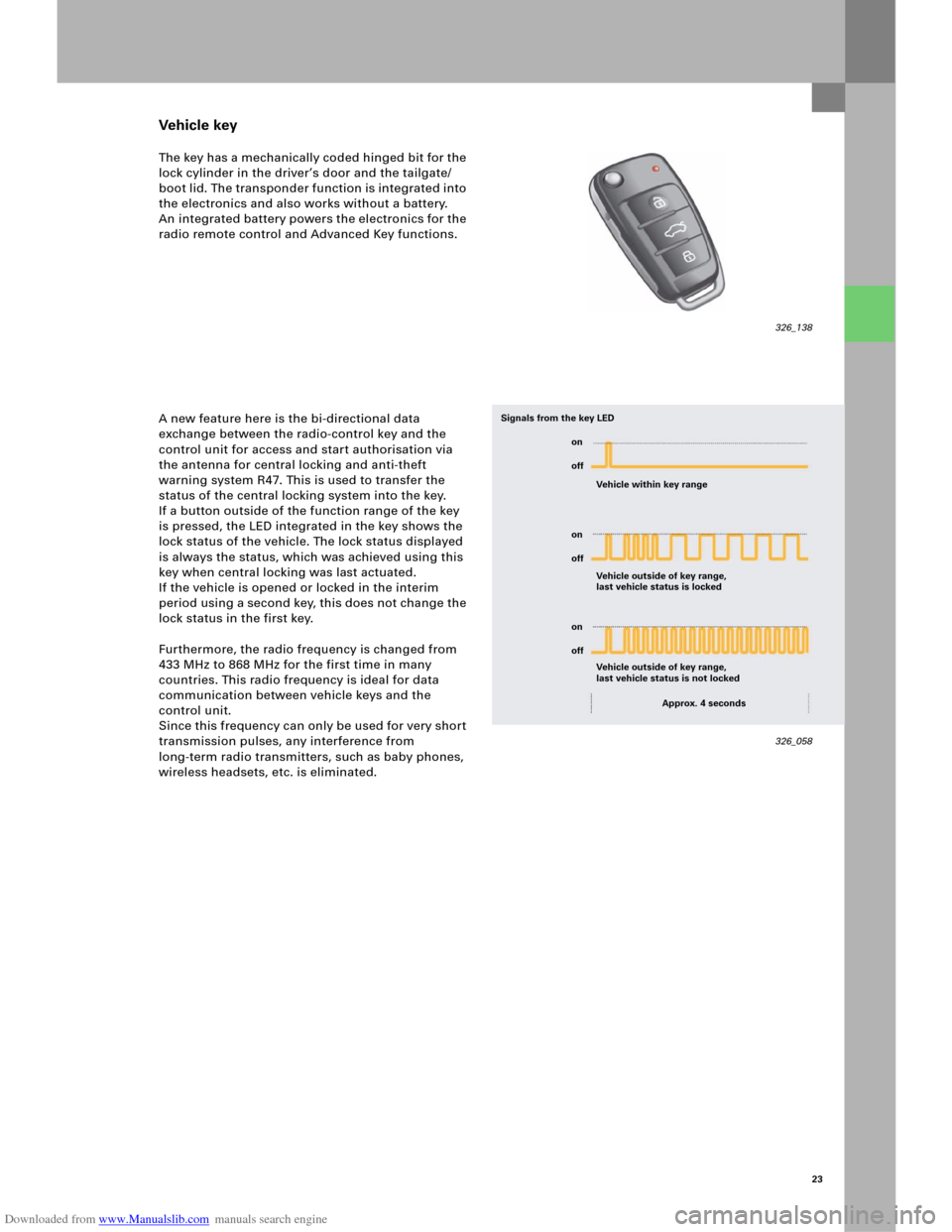
Downloaded from www.Manualslib.com manuals search engine 23
Vehicl e ke y
The key has a mechanically coded hinged bit for the
lock cylinder in the driver’s door and the tailgate/
boot lid. The transponder function is integrated into
the electronics and also works without a battery.
An integrated battery powers the electronics for the
radio remote control and Advanced Key functions.
A new feature here is the bi-directional data
exchange between the radio-control key and the
control unit for access and start authorisation via
the antenna for central locking and anti-theft
warning system R47. This is used to transfer the
status of the central locking system into the key.
If a button outside of the function range of the key
is pressed, the LED integrated in the key shows the
lock status of the vehicle. The lock status displayed
is always the status, which was achieved using this
key when central locking was last actuated.
If the vehicle is opened or locked in the interim
period using a second key, this does not change the
lock status in the first key.
Furthermore, the radio frequency is changed from
433 MHz to 868 MHz for the first time in many
countries. This radio frequency is ideal for data
communication between vehicle keys and the
control unit.
Since this frequency can only be used for very short
transmission pulses, any interference from
long-term radio transmitters, such as baby phones,
wireless headsets, etc. is eliminated.
326_138
326_058 Vehicle within key range
Vehicle outside of key range,
last vehicle status is locked Signals from the key LED
Vehicle outside of key range,
last vehicle status is not locked
Approx. 4 seconds on
off
on
off
on
off
Page 22 of 92
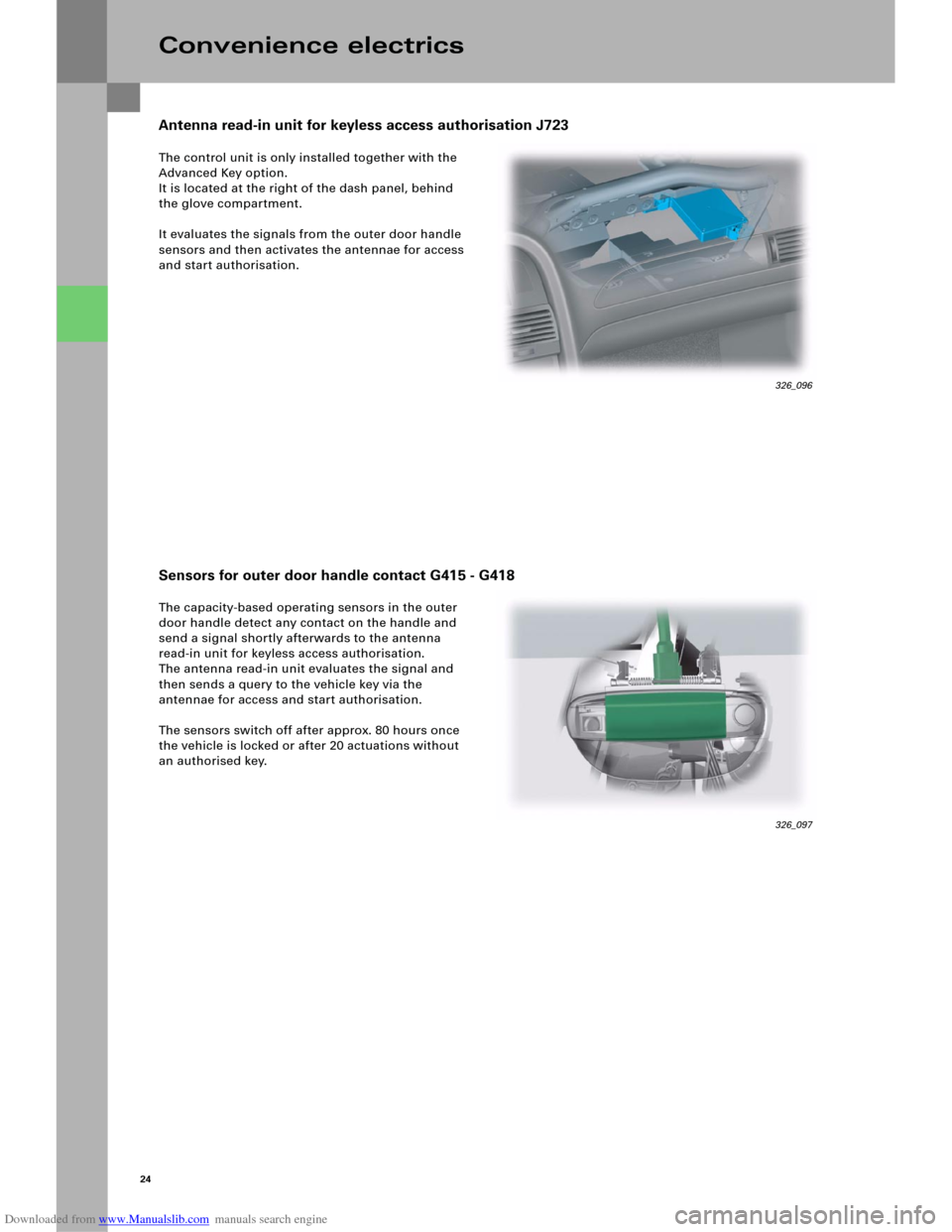
Downloaded from www.Manualslib.com manuals search engine 24
The control unit is only installed together with the
Advanced Key option.
It is located at the right of the dash panel, behind
the glove compartment.
It evaluates the signals from the outer door handle
sensors and then activates the antennae for access
and start authorisation.
The capacity-based operating sensors in the outer
door handle detect any contact on the handle and
send a signal shortly afterwards to the antenna
read-in unit for keyless access authorisation.
The antenna read-in unit evaluates the signal and
then sends a query to the vehicle key via the
antennae for access and start authorisation.
The sensors switch off after approx. 80 hours once
the vehicle is locked or after 20 actuations without
an authorised key.
Convenience electrics
326_097
Antenna read-in unit for keyless access authorisation J723
Sensors for outer door handle contact G415 - G418
326_096
Page 23 of 92
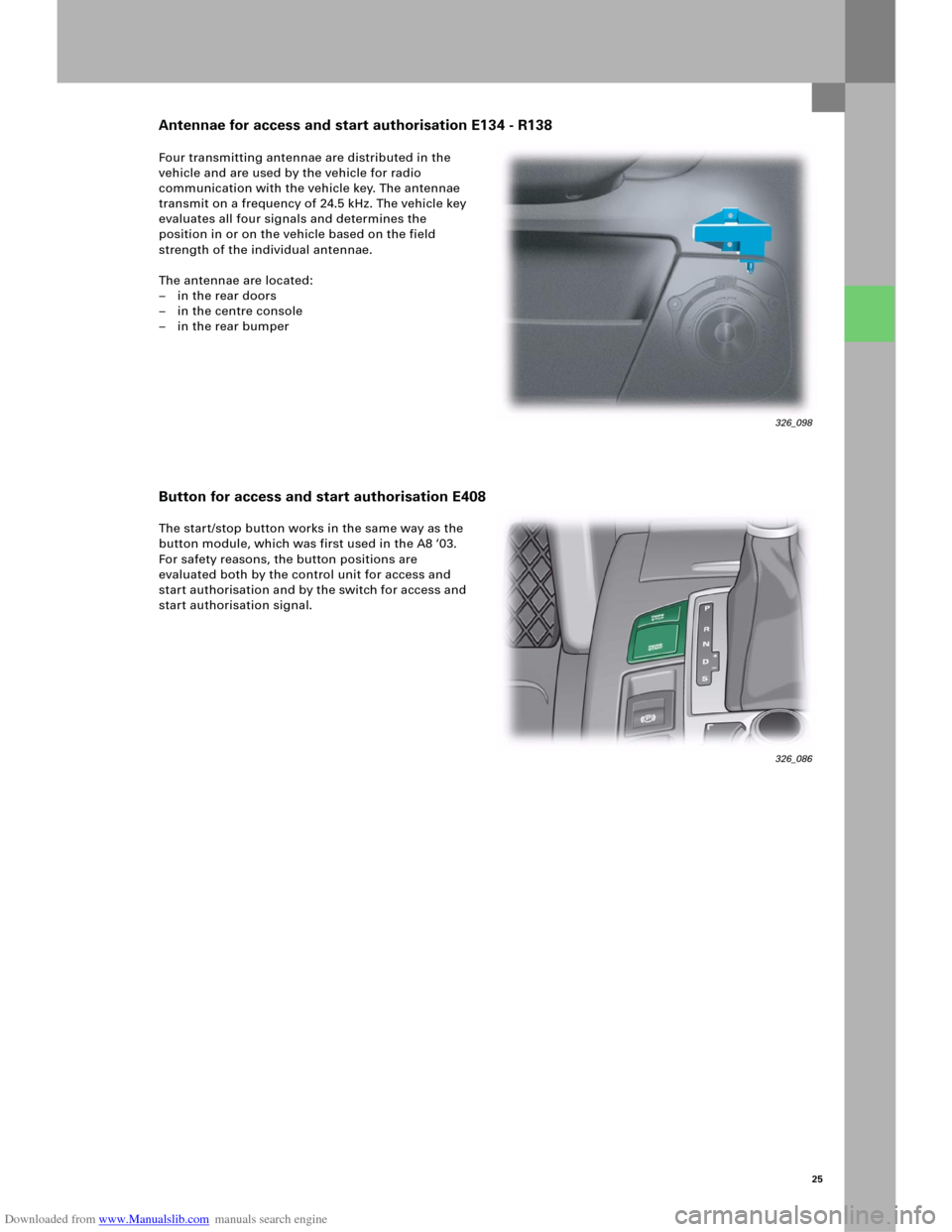
Downloaded from www.Manualslib.com manuals search engine 25
Four transmitting antennae are distributed in the
vehicle and are used by the vehicle for radio
communication with the vehicle key. The antennae
transmit on a frequency of 24.5 kHz. The vehicle key
evaluates all four signals and determines the
position in or on the vehicle based on the field
strength of the individual antennae.
The antennae are located:
–in the rear doors
–in the centre console
–in the rear bumper
The start/stop button works in the same way as the
button module, which was first used in the A8 ‘03.
For safety reasons, the button positions are
evaluated both by the control unit for access and
start authorisation and by the switch for access and
start authorisation signal.
Antennae for access and start authorisation E134 - R138
Button for access and start authorisation E408
326_086 326_098
Page 24 of 92

Downloaded from www.Manualslib.com manuals search engine 26
Opening the vehicle
Convenience electrics
326_055 Antenna for
central locking and
anti-theft warning
system
R47
Antenna on driver’s
side for access
start authorisation
R134Antenna on
passenger’s side for
access start
authorisation
R135Passeng er
compartment
antenna 1 for start
authorisation
R138
Boot antenna for
access
start authorisation
R137
Switch for
access and start
authorisation
E415
Antenna read-in
unit for keyless access
authorisation
J723 Control unit for
access and
start authorisation
J518
Door control unit,
driver’s side
J386
Central control unit
for
convenience system
J393Sensor for
outer door
handle contact,
driver’s side
G415
Page 25 of 92
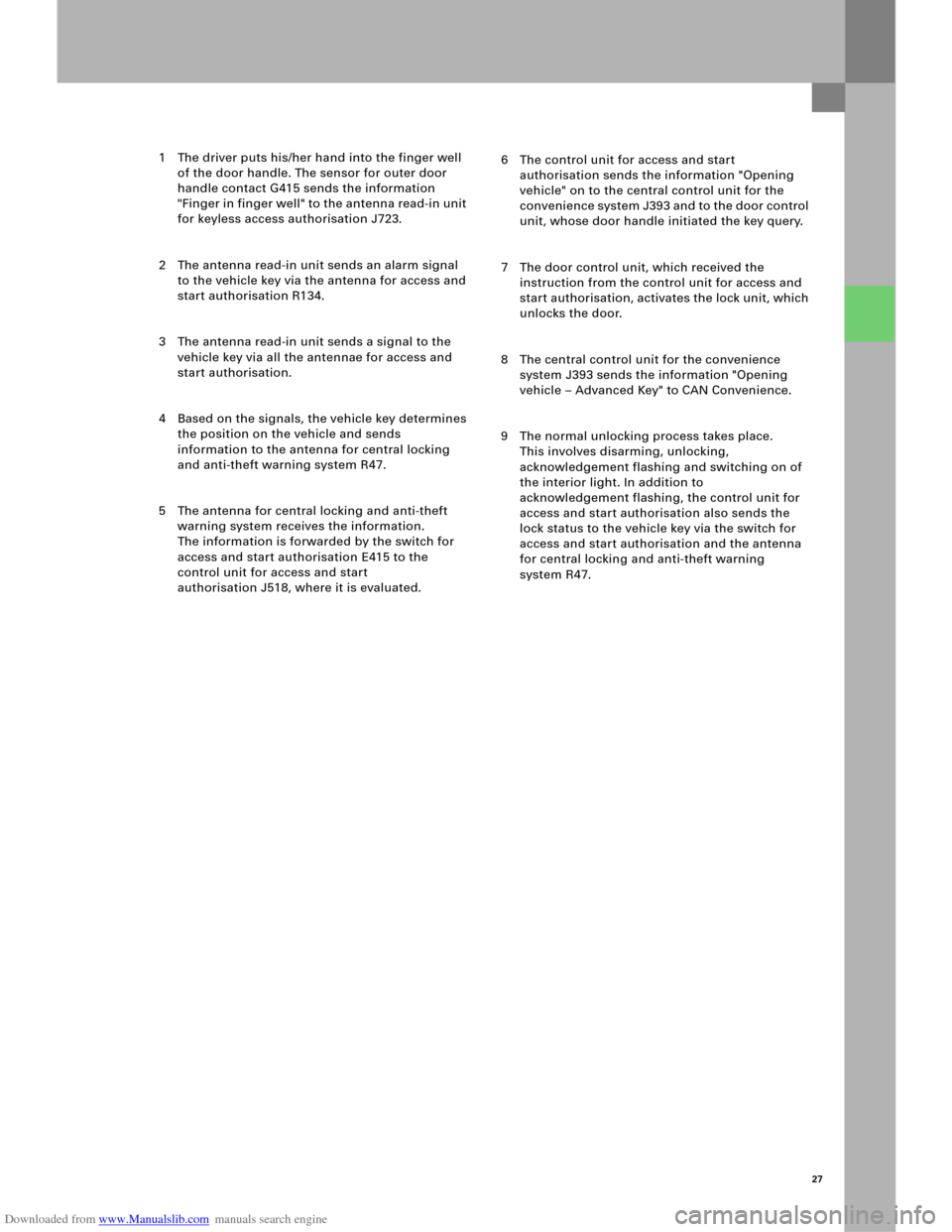
Downloaded from www.Manualslib.com manuals search engine 27
1 The driver puts his/her hand into the finger well
of the door handle. The sensor for outer door
handle contact G415 sends the information
"Finger in finger well" to the antenna read-in unit
for keyless access authorisation J723.
2 The antenna read-in unit sends an alarm signal
to the vehicle key via the antenna for access and
start authorisation R134.
3 The antenna read-in unit sends a signal to the
vehicle key via all the antennae for access and
start authorisation.
4 Based on the signals, the vehicle key determines
the position on the vehicle and sends
information to the antenna for central locking
and anti-theft warning system R47.
5 The antenna for central locking and anti-theft
warning system receives the information.
The information is forwarded by the switch for
access and start authorisation E415 to the
control unit for access and start
authorisation J518, where it is evaluated.6 The control unit for access and start
authorisation sends the information "Opening
vehicle" on to the central control unit for the
convenience system J393 and to the door control
unit, whose door handle initiated the key query.
7 The door control unit, which received the
instruction from the control unit for access and
start authorisation, activates the lock unit, which
unlocks the door.
8 The central control unit for the convenience
system J393 sends the information "Opening
vehicle – Advanced Key" to CAN Convenience.
9 The normal unlocking process takes place.
This involves disarming, unlocking,
acknowledgement flashing and switching on of
the interior light. In addition to
acknowledgement flashing, the control unit for
access and start authorisation also sends the
lock status to the vehicle key via the switch for
access and start authorisation and the antenna
for central locking and anti-theft warning
system R47.
Page 26 of 92
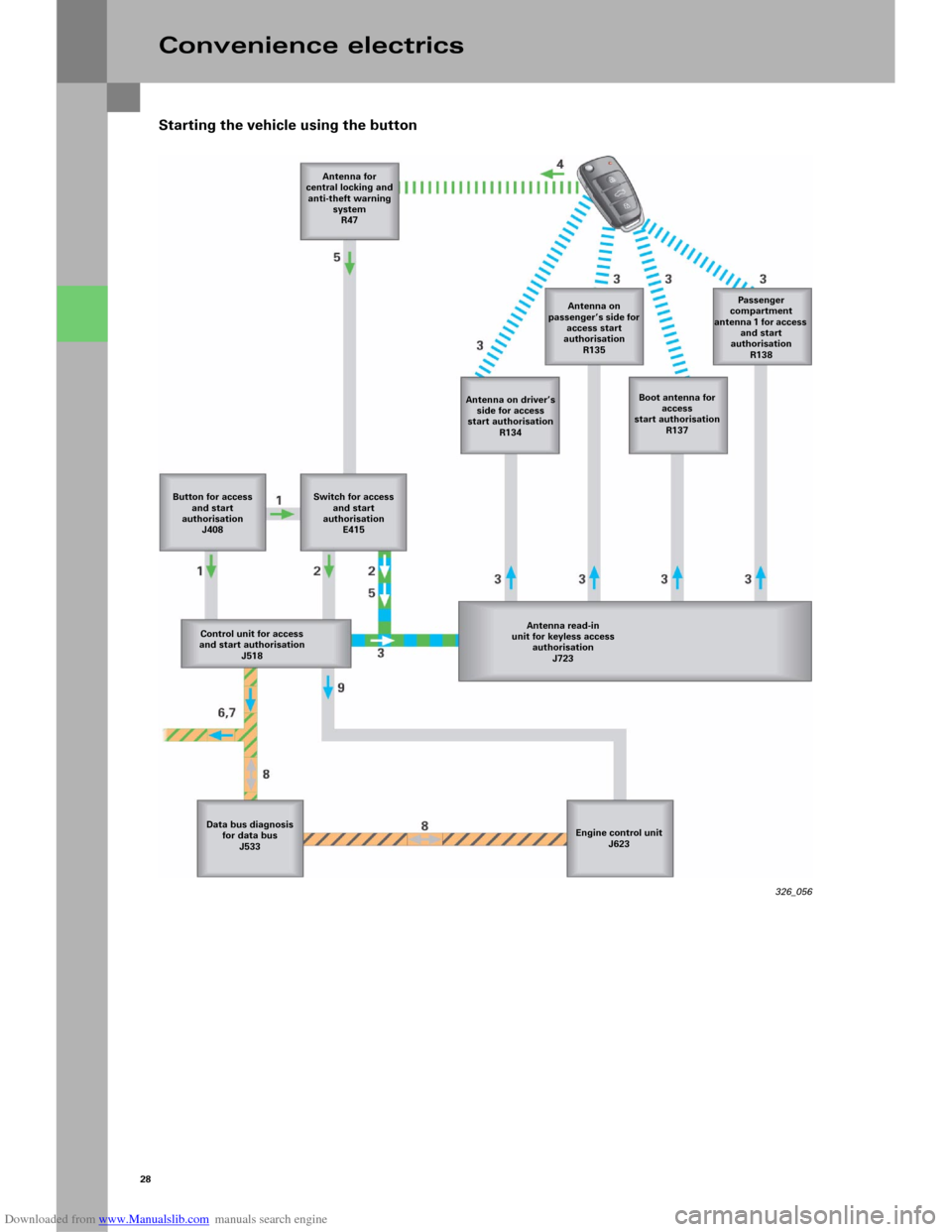
Downloaded from www.Manualslib.com manuals search engine 28
Starting the vehicle using the button
Convenience electrics
326_056 Antenna for
central locking and
anti-theft warning
system
R47
Antenna on driver’s
side for access
start authorisation
R134Antenna on
passenger’s side for
access start
authorisation
R135Passenger
compartment
antenna 1 for access
and start
authorisation
R138
Boot antenna for
access
start authorisation
R137
Switch for access
and start
authorisation
E415
Antenna read-in
unit for keyless access
authorisation
J723 Control unit for access
and start authorisation
J518
Data bus diagnosis
for data bus
J533Engine control unit
J623 Button for access
and start
authorisation
J408
Page 27 of 92
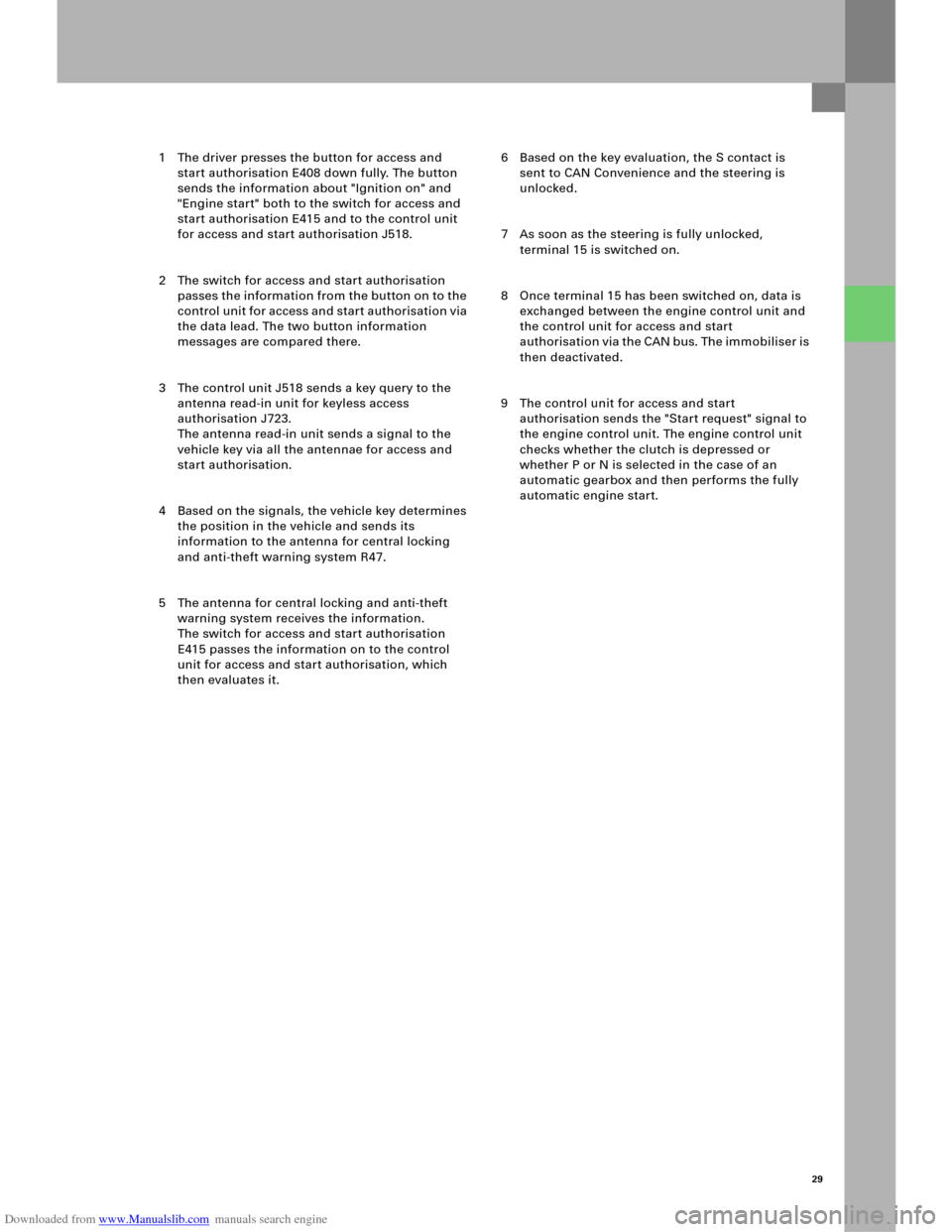
Downloaded from www.Manualslib.com manuals search engine 29
1 The driver presses the button for access and
start authorisation E408 down fully. The button
sends the information about "Ignition on" and
"Engine start" both to the switch for access and
start authorisation E415 and to the control unit
for access and start authorisation J518.
2 The switch for access and start authorisation
passes the information from the button on to the
control unit for access and start authorisation via
the data lead. The two button information
messages are compared there.
3 The control unit J518 sends a key query to the
antenna read-in unit for keyless access
authorisation J723.
The antenna read-in unit sends a signal to the
vehicle key via all the antennae for access and
start authorisation.
4 Based on the signals, the vehicle key determines
the position in the vehicle and sends its
information to the antenna for central locking
and anti-theft warning system R47.
5 The antenna for central locking and anti-theft
warning system receives the information.
The switch for access and start authorisation
E415 passes the information on to the control
unit for access and start authorisation, which
then evaluates it. 6 Based on the key evaluation, the S contact is
sent to CAN Convenience and the steering is
unlocked.
7 As soon as the steering is fully unlocked,
terminal 15 is switched on.
8 Once terminal 15 has been switched on, data is
exchanged between the engine control unit and
the control unit for access and start
authorisation via the CAN bus. The immobiliser is
then deactivated.
9 The control unit for access and start
authorisation sends the "Start request" signal to
the engine control unit. The engine control unit
checks whether the clutch is depressed or
whether P or N is selected in the case of an
automatic gearbox and then performs the fully
automatic engine start.
Page 28 of 92

Downloaded from www.Manualslib.com manuals search engine 30
Immobiliser 4
Convenience electrics
The immobiliser 4 technology is used in the
Audi A6 ’05.
This means that all components must be "taught"
online, as is already the case with the Audi A8 ´03
and the Audi A3 ´04.
The following components are integrated into the
immobiliser:
– The control unit for access and
start authorisation
– The engine control unit
– The vehicle keysControl unit, which is not integrated into the
immobiliser
Control unit, which is integrated into the
immobiliser
Master control unit
PC/mainframe
326_099
Immobiliser and component protection
E415 J518
J533 J623
Page 29 of 92

Downloaded from www.Manualslib.com manuals search engine 31
New identity
As is already the case with the Audi A8 ‘03 , if a
control unit is stolen, it is no longer necessary
(for safety reasons) to also replace the remaining
control units, which are integrated in the
immobiliser.
In this case, the "New Identity" function must be
used for the control unit for access and start
authorisation and the engine control unit.
It is only a matter of installing a new lock set before
using the "New Identity" function.
The switch for access and start authorisation E415
reads in the key code in electronic form only.
The hinged bit coding is not evaluated signal.
The ignition switch is not par t of the lock set for this
reason.
Component protection
As is already the case with the Audi A8 ’03, the
Convenience and Infotainment control units are also
integrated within the "Component protection" safety
system.
As a result, these control units must be adapted to
the specific vehicle once they have been installed.
The data bus diagnosis interface is integrated into
the "Component protection" function for the first
time. Since component protection works via a
number of control units, the Startup menu in
"Guided fault-finding" is not assigned to any one
control unit and can be found directly under the
self-diagnosis systems.
326_122 326_075
Audi
Audi A6 2005>
2005 (5)
Saloon
BBJ 3.0l Motronic / 160 kW Guided fault-finding
Function test
Teaching driving authorisation
systems
Te s t i n g q u e r y
The following options are available:
1. Adapt the driving authorisation system to suit
the existing immobiliser
2. Assign a new identity to the immobiliser and
re-teach the components
3. Terminate the function test
326_074
Audi
Audi A6 2005>
2005 (5)
Saloon
BBJ 3.0l Motronic / 160 kW Guided fault-finding
Function/component selection
Selecting a function or component
Body (Rep. Gr. 01; 50 - 97)
Electrical system (Rep. Gr. 01; 27, 90 - 97)
Component protection functions
13 – Distance control, Component protection
05 – Access and start authorisation, Component protection
15 – Airbag, Component protection
06 – Seat adjust. with memory, front pass. side, Comp. protection
36 – Seat adjust. with memory, front driver’s side, Comp. protect.
46 – Central module for convenience system, Comp. protection
66 – Seat adjustment with memory, rear, Component protection
07 – Display/operator unit, front, Component protection
17 – Dash panel insert, Component protection
27 – Display/operating unit, rear, Component protection
Switch for access and start authorisation E415
Page 30 of 92

Downloaded from www.Manualslib.com manuals search engine 32
External lights
Front headlights
Three different front headlights are used in the
Audi A6 ’05:
– Halogen headlights
–Bi-xenon headlights
–Adaptive light
Halogen headlights
Halogen headlights come as standard.
The following lamps are fitted in the halogen on the
vehicle equipment:
– W5W lamp for parking light
– H1 lamp for high beam headlight and headlight
flasher
– H7 lamp for dipped beam headlight and dimmed
as a daytime driving light
– An orange PY21W bulb as the direction indicator
light
The daytime driving light in the halogen headlight is
only available for Canada and the Northern
countries (Scandinavia). It is active when
terminal 15 is switched on and the parking light or
dipped beam light is off.
The following country-specific variants exist:
– The daytime driving light is part of the fog lights
for Canada and
– 3457NA flasher lamps are used for USA and
Canada.
A manual headlight range control system – with
potentiometer – is installed for halogen headlights.
Convenience electrics
326_087
326_149
12 3 4 5
1W5W lamp
2H1 lamp
3H7 lamp
4 PY21W lamp
5D2S lamp